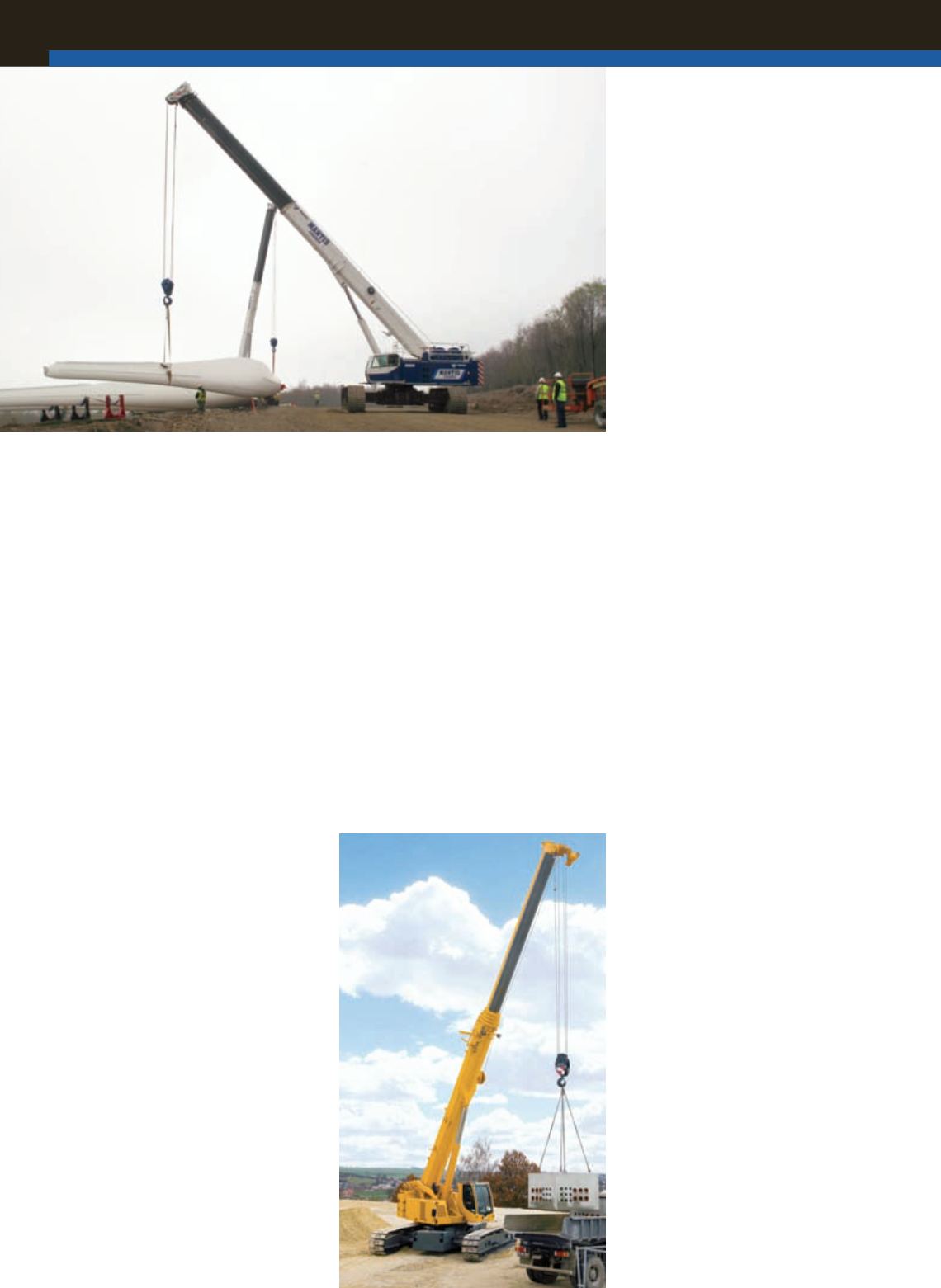
32
PRODUCT FOCUS
TELESCOPIC CRAWLERS
components to assemble a lifting crane
style of telescopic crawler is appealing, it
ignores the heavy-duty capabilities of the
telescopic boom crawler crane. Thus, we
design with the foundation industry as a
key focus market.”
No playing ‘catch up’
Self-described new-kid-on-the-block,
Link-Belt Construction Equipment
Company manufactures three telescopic
crawler cranes; the 45-ton TCC-450,
75-ton TCC-750 and 110-ton TCC-1100.
Pat Collins, senior product manager of
Link-Belt’s lattice and telescopic crawler
cranes, says, “As our telecrawlers are fairly
new in design and widely accepted there is
no ‘catch up’ for us to a trend or any other
manufacturer. Our overall charter for
design was driven by our customer input
and we received that message loud and
clear in that we follow function over fancy.
Customers want a very dependable – work
every day – telescopic crawler crane so
that is what we delivered on.”
Link-Belt included full pick and carry
ability in its 100-ton capacity TCC-1100
telescopic crawler. The crane comes with
a 150-foot, five-section full power boom
and is transportable in four loads.
The TCC-1100 is the company’s third
TCC (telescopic crawler crane) model
to be introduced to the series. For ease
of transport the crane uses lightweight
nylon head sheaves, which helps bring
the overall machine weight down while
also increasing its lifting capacity. A result
of this design means that the main unit
transports at less than 90,000 pounds.
Collins says TCCs also offer the ability
to navigate uneven terrain, steep grades
and softer ground conditions are at the
top of the “features and benefits” list.
Other benefits reside in the “categories
of speed and space,” he says. “Speed from
the standpoint that when you compare a
telecrawler to a rough terrain crane, all-
terrain crane or truck crane, you do not
have to deal with deploying outriggers,
which is a time saver, as well as the need to
put down cribbing other than for leveling,
as required. Then there’s retracting the
outriggers, picking up the dunnage and
moving again versus the telecrawler just
moving. You take all of that, and speed can
be a very big advantage for the telecrawler.”
Collins says the next big benefit with
telescopic crawler cranes is the units’
ability to operate in confined spaces.
“A telecrawler can work in a very tight
envelope with low overhead conditions,”
he says. “Normally an outrigger machine
is going to require full span or partially
span extended outrigger beam clearance
and the telecrawler has the ability to
work well inside those conditions; jobsite
space is getting harder to come by, not
easier. Compared to lattice crawlers, the
telecrawler can retract its full boom in a
minute and be on the move to another
location; so generally speaking, it’s going
to be faster – more nimble – than a lattice
crawler.”
According to Autry with Mardian, one
of the major focuses for telescopic crawler
crane manufacturers moving forward will
be improving the cranes’ ease to assemble
and disassemble as well as mobilization.
“Link-Belt’s telescopic crawler cranes
have this exactly in mind with their
fold-up catwalks, hydraulic retractable
side frames and easy hydraulic counter
weight removal,” Autry says. “Crane
manufacturers are also focusing on
improving overall processes by designing
their cranes on a modular basis, so that
standard components can be used for a
whole range of product. Not only does this
help keep manufacturing costs down, it
reassures buyers that proven technology
is being used and replacement parts are
likely to be more readily available when
needed.”
Bigger units
Liebherr manufactures a number of
telescopic crawler cranes, including the
LTR 1060 with a maximum load capacity
of 60 tons, the 100-tonner LTR 1100, the
new LTR 1220 and the 1,200-ton LTR
11200 heavy lift crane with narrow crawler
travel gear.
“The crawler travel gear provides
excellent off-road capacity and superb
maneuverability, as well as allowing
the crane to travel under full load,”
says Wolfgang Beringer, head of sales
promotion, Liebherr-Werk Ehingen
GmbH. “The advantages of a telescopic
crane over a lattice boom crane are the
short set-up times, easier transport and
the variability of the boom system. The
telescopic boom is extended or retracted
fully automatically and rapidly to the
desired length, allowing it, for example, to
pass easily beneath obstacles.”
Liebherr’s LTR 1220 also provides
the advantage that heavy loads can be
telescoped with the boom, which in
principle is not possible with lattice boom
cranes. “And because a crawler crane,
unlike a mobile crane, does not need to
be supported, it can be rapidly set up on
site and can go into action immediately,”
Beringer says.
■
ACT
JULY 2013
Empire Crane Company recently bought
two new Tadano Mantis telescopic
crawlers for wind farm work.
The advantages of a telescopic
crane over a lattice boom
crane are the short set-up
times, easier transport and
the variability of the boom
system, according to
Wolfgang Beringer,
Liebherr-Werk
Ehingen GmbH.


